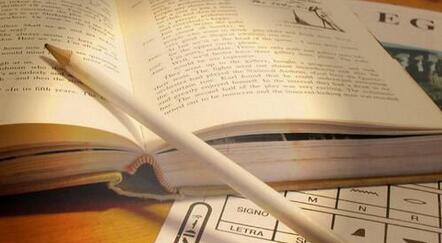来源:环球教育无锡学校
小编:谢凌飞 234修辞目的是一个典型的托福题型,至少在同类其他考试中没有明确出现Rhetorical Purpose这个说法。这个题型有两种分类方法,一种是把作者目的题、篇章结构题、段落目的题这三小类合并称为修辞目的题。另外一种就是把作者目的题等同于修辞目的,而剩下的篇章结构、段落目的划分到托福的稀有题型之中。本文的分类是采用前者,因为作者目的题是关注的作者的目的,篇章结构是指结构的目的,段落目的题关注的是段落的目的。只是,这三种小题型中,作者目的题考到的频率最高。
鉴于此,我们先从作者目的入手,简单介绍几种做这类题目的思路。作者目的题是每套托福考试中必然会出现的题型之一,必然出现,但是难度相对来说是比较简单的,所以也可以列为必须拿分的题型。我们先来看个例子:
Sensitivity to physical laws is thus an important consideration for the maker of applied-art objects. It is often taken for granted that this is also true for the maker of fine-art objects. This assumption misses a significant difference between the two disciplines. Fine-art objects are not constrained by the laws of physics in the same way that applied-art objects are. Because their primary purpose is not functional, they are only limited in terms of the materials used to make them. Sculptures must, for example, be stable, which requires an understanding of the properties of mass, weight distribution, and stress. Paintings must have rigid stretchers so that the canvas will be taut, and the paint must not deteriorate, crack, or discolor. These are problems that must be overcome by the artist because they tend to intrude upon his or her conception of the work. For example, in the early Italian Renaissance, bronze statues of horses with a raised foreleg usually had a cannonball under that hoof. This was done because the cannonball was needed to support the weight of the leg. In other words, the demands of the laws of physics, not the sculptor's aesthetic intentions, placed the ball there. That this device was a necessary structural compromise is clear from the fact that the cannonball quickly disappeared when sculptors learned how to strengthen the internal structure of a statue with iron braces (iron being much stronger than bronze).
Why does the author discuss the bronze statues of horses created by artists in the early Italian Renaissance?
A. To provide an example of a problem related to the laws of physics that a fine artist must overcome
B. To argue that fine artists are unconcerned with the laws of physics
C. To contrast the relative sophistication of modern artists in solving problems related to the laws of physics
D. To note an exceptional piece of art constructed without the aid of technology
首先,这道题的段落来源很长,这就意味着定位是一个难点。我们根据statues of horses、 Italian Renaissance定位到"For example, in the early Italian Renaissance, bronze statues of horses with a raised foreleg usually had a cannonball under that hoof."然后问题来了,我们到底是看定位句本身呢,还是看前一句、后一句?这个时候,我们可以还原这个题型的出题目的。既然是作者目的题,就是作者说这句话、举这个例子是为了啥?所以,我们更应该关注的是作者举出这个例子的背后含义。不然发现,这个句子是由For example引起的。既然这个句子只是一个例子,那我们就要找到这个例子论证的论点。很显然,就是前一句了。而前一句又正好可以跟选项A匹配,所以答案为A。

我们再看一道题来验证一下。
Paragraph 3: Watt's steam engine soon showed what it could do. It liberated industry from dependence on running water. The engine eliminated water in the mines by driving efficient pumps, which made possible deeper and deeper mining. The ready availability of coal inspired William Murdoch during the 1790s to develop the first new form of nighttime illumination to be discovered in a millennium and a half. Coal gas rivaled smoky oil lamps and flickering candles, and early in the new century, well-to-do Londoners grew accustomed to gaslit houses and even streets. Iron manufacturers, which had starved for fuel while depending on charcoal, also benefited from ever-increasing supplies of coal: blast furnaces with steam-powered bellows turned out more iron and steel for the new machinery. Steam became the motive force of the Industrial Revolution as coal and iron ore were the raw materials.
In paragraph 3, the author mentions William Murdoch's invention of a new form of nighttime illumination in order to
A. indicate one of the important developments made possible by the introduction of Watt's steam engine
B. make the point that Watt's steam engine was not the only invention of importance to the Industrial Revolution
C. illustrate how important coal was as a raw material for the Industrial Revolution
D. provide an example of another eighteenth-century invention that used steam as a power source
这道题依然问的是作者提及……的目的。那我们先根据题干中的William Murdoch定位到本段第三句,可是按照刚刚一道题的思路:"本句话不重要,重要的是它所论证的前一句话。"看第二句话"引擎使得煤矿的可获得性提高"发现并没有找到相应的选项。这时候,我们不妨尝试另外一种思路:主旨暗示。作者说的每一句话都是存在于段落之中的,所以都是为段落服务的,所以该例子也可以说明主旨。那么从这个角度去思考时候,我们发现本段主旨就在开头,说明了蒸汽引擎的重要性,答案为A。
到这里,我们总结一下。作者目的题的正确选项一般可不看定位句本身,可以先看定位句前一句,如果能找到与前一句匹配的选项就直接选择;如果不能找到与前一句匹配的就找一下段落主旨。至于为什么要先看前一句而不是先看主旨,是因为有时候主旨不明确,可能会导致有些同学找错主旨。
关于作者目的题,可能还会有别的方法,比如说通过文章主旨来做题,这个在这儿就不做介绍了,因为利用率相对偏低。另外,修辞目的题的其他两种小题型我们留着以后再介绍。希望本文可以给备考托福的考生一些解题思路。当然,万变不离其宗,如果可以理解文意,可以明确文章结构,那么自然是锦上添花的了。